|
FAQs about Giant Clam Disease, Pests &
Predators 6
Related Articles: Example Chapter
from NMA Reef Invertebrates book, on Giant Clams, Tridacnids, A Brief
Guide to the Selection and Placement of Tridacnid
Clams by Barry Neigut,
Bivalves,
Mollusks, Lighting Marine
Invertebrates,
Related FAQs: Tridacnid Health: Pinched
Mantle Syndrome in Giant Clams by Dr. David Basti, Deborah
Bouchard & Barry Neigut, Tridacnid Disease 1, Tridacnid Disease 2, Tridacnid Disease 3, Tridacnid Health 4, Tridacnid Health 5, Tridacnid Disease 7, Tridacnid Disease 8, & Pest Snails (Pyramidellids...),
FAQs on Giant Clam Disease by Category:
Diagnosis,
Environmental, Nutritional,
Social, Trauma,
Pathogenic,
Treatments
Tridacnid Identification, Tridacnid Selection, Tridacnid Compatibility, Tridacnid Systems, Tridacnid Lighting, Tridacnid Placement, Tridacnid Feeding, Tridacnid Reproduction, Tridacnids 1, Tridacnids 2, Tridacnids 3, Tridacnids 4, Tridacnid Clam Business, Bivalves, Bivalves 2, Lighting Marine
Invertebrates,
|
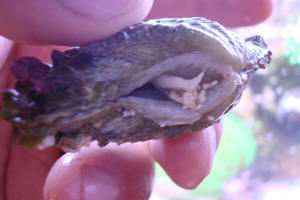
|
Tridacna derasa quarantine:
7/13/2009
Hi Guys!
<Howdy!>
Please forgive me if the answer to my question lies in your immense
FAQs, but I was unable to find it so I thought I would just ask.
<Sure thing.>
I have just purchased a *Tridacna derasa*. I'm very excited as you
might imagine. But, I'm confused with the quarantine. The clam is
approximately 3-1/2 inches. I know that it is always recommended to
quarantine for 2 weeks at minimum.
<Yes>
But, I'm a little afraid that it might attach itself to the bare
tank bottom and I won't be able to move it.
<A valid concern, but easily corrected by giving the clam something
portable to attach to, such as a old shell or a small piece of rock.
>
I'm also wondering if placement in the display tank would offer
better water flow, nutrients, and lighting.
<It would>
Would you still recommend a 2 week quarantine?
<If it is your only clam and you are certain that it is not carrying
any parasitic snails that will devour it, yes, you can go ahead and put
it in your display. Do watch it closely, particularly after lights out
for signs of snails. If you had existing clams, I would quarantine it
for the two weeks.>
As always you guys are the best!
Thanks for responding.
<My pleasure.>
<MikeV>
|
Tridacnid HH 6/29/09
Dear Crew at WWM,
Thank you so much for all of the information you have here & the
references, my husband & I have truly enjoyed learning about our
beautiful tank inhabitants. Our original tank was last up 15 years ago
so things have changed a lot since we started back in the hobby 6
months ago. We currently have a 125g tank, with spot on water
parameters and all critters doing very well. My question is about a
baby T. squamosa that I just purchased last week. Roughly 2" (5cm)
long,
<Mmm, very small clams have a historically high incidental
mortality>
beautiful caramel, honey, golden brown with turquoise spots--quite
beautiful. Acclimated the baby, put it in quarantine, & introduced
it to the tank--seems fine, mantle all the way over, reacts well to
light, etc...as my hubby was feeding our plate corals & anemones,
out of the inhalant siphon came a white worm looking
'thing'
<Might be a worm...>
about 1cm long 1/4cm wide. By the time I grabbed the camera to take a
photo, it had disappeared. I have since spent hours trying to see this
'thing' since yesterday evening...can anyone help me with this
description? I am horrified if there is a beastie in my baby or if it
can reproduce and attach itself to any of our tank critters.
Many thanks in advance for your response, I truly do appreciate it.
Tracey
<There are organisms that live as space "parasites",
commensals for the most part... So send along an image if/when you can.
Bob Fenner>
Re: My baby squamosa clam, not HH --
07/01/09
Dear Kind Crew,
<Tracey>
I wrote to you a couple of days ago with the query of a beastie
being seen in my new baby squamosa. After spending hours watching
the babe-camera in hand, I did move him up to the rock...Please
find attached a photo & I would so appreciate if you could
let me know if & what this moving 'appendage'
is...
<The whitish object to the lower right? The excurrent
siphon>
I await your comments--and thank you so much for the absolute
invaluable advice you post--you're my favourite reference
site!
Best regards,
Tracey
<Do keep an "eye" on that urchin... can be
problematical in poking clam mantles. Bob Fenner>
|
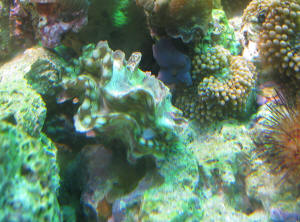 |
Coral and Clam Competing for Turf
5/5/09
WWM Crew:
<Josh Here>
I've been lucky enough to have the livestock in my reef tank
flourish, but now I fear that I'm running into an issue where I
have too many creatures competing for limited reef space. I've been
able to somewhat successfully deal with this problem in the past, but
now I'm in a bit of a pickle. I've attached a photo of my
problem area. Obviously everything is attached to the rock, so I
can't easily move anything. I'm most concerned about the clam
getting stung, and I don't really care about the mushrooms or
Zoanthids if they need to be removed.
<The clam may be getting close there... but they don't seem
quite as close as you make it sound. Anyway, it couldn't hurt to
separate them. While it certainly isn't ideal for the clam to be in
contact with the coral, do Google search some for some photographs of
giant clams in the wild, (often surrounded by corals).>
Will the clam survive if I allow it to be smothered by the Zoas and
Shrooms, and if not, what is the best way to remove the Zoas and
Shrooms. I'm afraid that scraping them away with razor blade will
release toxins into the water. Thanks in advance for your help.
<Should be fine to scrape, if this rock is like most live rock, it
may be just as easy to scrape away a layer of live rock with the corals
attached as to scrape the corals themselves.>
Sincerely,
Jesse
<Good luck with the coral relocation...
Josh Solomon>
|
Tridacnid Maxima Disease 02/09/09 *Sorry,
forgot to attach images in previous email* Hello WWM, I have
searched all of the five pages on Tridacnid disease and have not
found an answer to my question, so I hope that someone will be
able to help me. My Maxima clam has been fine for months since I
have had him (purchased tank Sept 08, Maxima came with it, in
tank at least 6 months before that). In the past few weeks a
brown colored film seems to be growing on the shell. <I see
this> I have tracked its progress, and it is spreading. The
clams behavior seems fine, mantle looks ok, it fully extends
during lighted hours, but this recent development worries me.
Please take a look at the two attached pictures and tell me if
you can identify it. Thanks in advance. Landon <Need much more
resolution here to tell... Could be a simple algal growth... of
not much consequence... Perhaps a Hydroid colony... a Bryozoan...
IF concerned, IF this growth appears to be deleteriously
affecting the Tridacnid, I would take the clam out, and scrub the
area (underwater) in a bucket of water outside the system. Bob
Fenner>
|
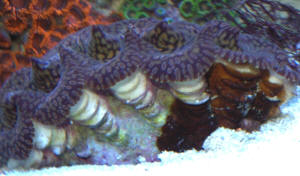 |
|
Clam Question... I'm not seeing the problem
11/17/2008 Hi. <Hi Eric, Mich here.> I seem to be
having some sort of problem with my clam. I thought it was the
fact that that an angel was nipping at it, but that having been
solved by removing the fish, I still see these grayish, whitish
spots on the mantle. <Mmm, I'm not exactly sure what
you're referring to here. I'm not seeing anything that
looks out of the ordinary consistently in your pictures.> It
started in one place about six months ago and progressed across
the mantle. <The picture ending in 126 appears to be your
clearest photo and the one I am relying on most here, but I'm
not seeing anything that looks abnormal to me. Working from the
outside of the mantle inwards, I see bright blue spots on dark
purple, then a lighter brownish-purple, and then more bright blue
spots. My guess is perhaps you are concerned about this lighter
brownish-purple section, but this looks like normal color
variation to me. When clams are moved into new
environments/lights the colors often appear different.>
I've looked for worms at night and have not seem them or
anything else for that matter. <Mmm, I guess I'm not
surprised?> I'd would appreciate it if you could lend your
expert eyes to the attached pictures and hopefully offer a
diagnosis. <I do not see anything that appears concerning to
me, If I've overlooked something please let me know.>
Thanks, Eric
<Welcome, Mich>
|
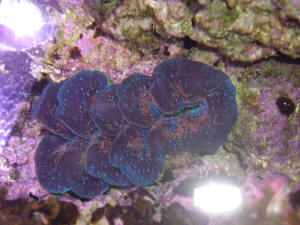 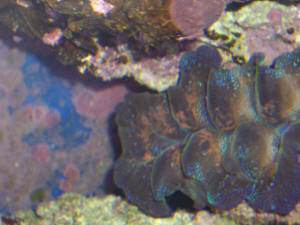 |
|
Re: Clam Question Clam Question...
I'm not seeing the problem 11/20/2008 Thanks for the
response. <Sorry, I'm not more help here.> I guess the
pics don't provide enough color differentiation. <I'm
just not seeing much, I'm sorry.> The spots are grayish
white and it doesn't look natural. <Could be bleaching,
which is the loss of the symbiotic algae known as Zooxanthellae,
is sometimes related to changes in lighting among other things.
More here:
http://www.wetwebmedia.com/ca/volume_1/cav1i3/Clam_care/Clam_care.htm >
However, since I removed the angel, the clam has started using
calcium again, so maybe he'll be ok. <Let's hope.>
Thanks again, Eric <Welcome, Mich>
|
Re: Tridacnid byssal gland trauma
11/16/08 Sara-Have another question for you, just FYI, the
clam I have previously inquired about is doing very well, so apparently
I was just overreacting. <Ah, cool> My next question however, is
one I can't find an answer to anywhere. What are the general
guidelines for stocking levels of Tridacnids? I would like to have
several in my tank (30 gal w/ 15 gal refugium) but don't want to
have them over compete for nitrates, etc. Is there a rule? I kind of
wanted to add a crocea and derasa in addition to the maxima I currently
have. Let me know! <Well, I honestly don't know of any real
"rules" about it... but these animals are primarily
photosynthetic. So they don't add to your "bioload" the
same way fish do. Also, they grow at different rates (depending on the
individual-- it's apparently a genetic thing). I imagine that how
many you can keep in a tank depends on how fast they grow (since this
will likely be the primary determining factor for how many nutrients
they consume). If you can find some of the "slower growers" I
think you could probably put as many in a tank as will comfortably fit.
The problem is that you can't just look at a clam and know if
it's a slow or fast grower. If I were you, I'd go to a LFS
that's had some clams for awhile and ask them if they've
noticed how fast or slow each of them has been growing. Explain that
you're not necessarily looking for the fastest growing clam or else
they'll like over-state the growth rates because they assume you
want a fast growing one. In any case, I do think you could have 3
smaller (<6in fully extended) clams in the 30g tank. Even if they
turn out to be super-fast growers, I'm sure you'd have no
trouble placing (or even selling) it to someone else. The fast growers
are more "in demand" as they say. Also note, if you're
worried that your clams aren't getting enough nutrients, you can
always just decrease the time you have the skimmer on. Also, please do
pick up James Fatherree's book on ornamental clams... it's very
good, and you seem to have the interest for it.> Thanks, Chad S
<De nada... hope this helps, Sara M.>
|
Re: Squamosa death and Maxima Issues.
11/15/08 I went to the LFS today to verify everything.
My salinity was a little higher due to the difference between my
rinky dink plastic hydrometer and their refractometer but here
are the parameters as of today... The tank is a 120 gallon with a
29 gallon fuge and ~30-40 gallons in the sump plus what is
contained in the skimmer. KH=110ppm Ca=400 Nitrate=undetectable
Nitrite=undetectable Phosphate=undetectable Salinity=1.027 ( I
normally try to keep it around 1.025 or 1.026, I will be
purchasing a refractometer soon) The only thing that I can figure
is that the new Squamosa did not like the new flow pattern. The
LFS guy said that trimming back the Montipora and the small
movement of the powerhead changed the flow dynamics of the water.
This could have caused the clam to exert what energy it had into
moving <?> into a lower flow area and that led to it's
demise? <Possibly> This sounds like it could be true but I
wanted another opinion. He and I do not always see eye to eye
when it comes to our views on husbandry practices. I have also
down sized the picture of the maxima. <The Byssus doesn't
look good> Another quick question, does Cyano bacteria grow in
small patches... sort of like coralline. <Some species can,
definitely> I thought I had some dark maroon coralline algae
but pulled a rock out to trim some Acro and scratched at the
maroon growth. It was not entirely soft but I could scratch some
of it off. There is a small bit of Cyano started in the corner of
the fuge, but it is the typical long stringiness. <Mmm,
"comes" in a wide variety of shapes, colors...>
I'm guessing this could be attributed to the skimmer issue I
had ( will discuss in a second) and the maxima dying. I have done
two ~15 gallon water changes in the past week and a half and plan
to continue if this is a Cyano problem. I also swapped out my
EV120 for my ASM G4. The EV120 injector was continually being
infested by snail larva and not working correctly, so I ditched
it but I fear that the multiple skimmer failures may have caught
up with me. The growth in question is also in high flow areas of
the tank, which I didn't think was characteristic of Cyano?
<Again... Please read here:
http://wetwebmedia.com/bluegralgae.htm and the linked files
above... You'd do well to investigate RedOx potential as
well.> Thanks again guys, Adam
<Welcome. Bob Fenner>
|
 |
Giant clam malady? Mg toxicity --
09/04/08 Hi Bob (and crew), <Hi Chris, Mich here.>
Thanks for the many hours that you have collectively invested in the
hobby and in this website. It is a great resource. <Thank you for
your kind words here.> I am having a problem with the mollusks in my
tank that I haven¹t been able to resolve after looking at
the snail disease faq, the giant clam disease faq. or
Fatherree¹s clam book. <OK, hopefully I can help.> My
tank is a sps dominated mixed reef. Salinity is 1.024, pH
is 7.8-8.1 (lower than I would like it to be) <Yes.> temp 78.5,
ammonia, nitrate and nitrite are all not detectable, PO4 is around
.25-.5 ppm (more than I would like), because of my high coral load and
the presence of a large clam I am having trouble keeping my calcium and
Alk where I would like them to be. My dKH hovers around six and my
calcium is around 325. I know that these levels are too low and I am
currently investing in a calcium reactor and Kalk reactor, which will
be employed under the vigilance of an aqua controller to address this
problem. My Mg is around 1300ish. <I think this maybe part of your
problem.> I currently dose what seem to be excessive amounts of
DT¹s 3-part calcium mg and Alk buffer to compensate for bio
depletion and to raise pH. <OK.> Lighting is a 10,000K 250W metal
halide. Tank turnover is about 50X. I have a 1 inch sand bed which I
gravel vac as part of my weekly maintenance. I typically do at least
10% water change every week. (more often 25%). <Husbandry seems
good.> I have great coral and clam growth and no algae problems.
<Wonderful!> As for fish I¹m a fan of a relatively
conservative fish load. I have a small flasher wrasse, a Banggai
cardinal, a mandarin and a yellow assessor. (no coral eaters or clam
nippers) <Great!> On to the problem: About a week and a half ago,
my T. crocea (~5.5 inches) decided he was no longer happy as a clam.
During the daytime, he remains mostly closed with his mantle mostly
retracted. It does open ~75% in the mornings when natural sunlight hits
his corner of the tank. It also seems to be expanded to a greater
degree when the lights are off (~25%). The clam is still light
responsive and appears to have no signs of pinched mantle, white spot,
obvious necrosis or parasitic snails. It is located on a small rock on
the bottom of my tank about 13² under water (mantle is at a
10² depth). It¹s byssal attachment is still
quite strong. <OK.> I¹m concerned that he
hasn¹t been opening. <Rightly so.> Since the
situation arose, I have employed activated carbon in the tank in hopes
of removing any DOC toxins that might be present and have done three
25% water changes in the past week and a half. <Well your carbon
usage has likely cleared your water significantly, which may make your
clam more sensitive to light.> I would be content to call this an
issue related to the clams exposure to light in the tank BUT, I have
noticed my Astrea snails have been remarkably lethargic lastly as well.
<I think this is likely related to your high Magnesium levels and
low Calcium levels.> One snail laid on his side half open for ~12
hours others have not moved for several days on end. I have not noticed
any snail deaths. <Here is my theory: You are likely seeing
paralysis from the high Mag levels/ low Calcium. Magnesium Sulfate
(MgSO4) in the human acts as a central nervous system depressant. It
blocks neuromuscular transmission by decreasing the amount of
Acetylcholine released by motor nerve impulses. A secondary effect is
the relaxation of smooth muscle tissue. MgSO4 is also the most commonly
used tocolytic agent, it decreases the frequency and intensity of
uterine contractions associated with preterm labor. It is also used to
prevent seizures and convulsions..Mag toxicity is a huge concern in
something the size of a human, let alone a tiny snails. When MgSO4 is
given in a hospital setting the antagonist, calcium, typically calcium
gluconate, is kept at the bedside. Patella Tendon reflexes are
continuously monitored for signs of diminished or absent reflexes
related to the risk of overdose. This is why I suspect your problems
may be related to the Calcium level and Magnesium levels in your
tank.> Any thoughts?? (sorry for the long email) <I do think this
is a water chemistry issue. I think you should try raising your dKH,
pH, and Calcium levels and lower your Magnesium levels.> Thanks,
<Welcome,> Chris <Michelle Lemech MS RN>
Re: Giant clam malady? 10/8/08 Hello
Mich, <Hi Chris,> Thank you for you well thought out response!
<Welcome!> I think you are on to something. <Well, makes sense
in theory I think.> In retrospect, I *think* I noticed more mantle
extension on mornings after large doses of 2 part calcium buffer
(without the Mg dose) and on mornings after CaOH was dosed. Depletion
of calcium by mid morning could result in recurrence of the symptoms.
<OK.> I had considered the idea of calcium depletion toxicity
before, but discounted the theory because the clam was sill
photo-reactive. I figured that adductor contractility would have also
diminished if calcium was so low that it was interfering with either
action potential propagation, cell signaling or smooth muscle
contraction. <I suppose internal levels could be higher.> I have
no idea about the histology of the adductor muscle. Is it smooth or
striated? ( I guess this doesn't really matter.) In the past week
my snails seem to have been doing much better. This is concurrent with
your theory that this this is a chemical problem rather than a
biological one. If I had some sort of pathogen in the tank the snails
should have been the first to kick the bucket rather than get better.
<Does support a chemical issue.> I am not sure, but I think I may
now have a secondary protozoan infection. When the mantle of the clam
is withdrawn (aka not midmorning when the sun hits the tank after a
good shot of calcium) there is now a slight curl to a small portion of
the mantle. When the clam is extended, here is no sign of pinched
mantle what so ever. Do you think I should try and do a freshwater dip?
<Mmm, think I would wait here.> Having decided that calcium
depletion is a possible cause (and an issue that needs attention in my
reef regardless, I am unsure how exactly to proceed. Specifically, I am
wondering about adverse effects of GREATLY overdosing my system with 2
part buffer to increase the Ca levels. Do you know of any trace
elements present in 2-part that will reach toxic levels if I am dosing
WAY beyond the recommended dosage (as I would have to get levels where
they ought to be) ? <I'm sorry but I do not have experience with
this.> What do you think? <I think it is worth trying and just
keeping a close eye on things.> Thanks again for your ideas and
input! <Welcome.> Chris <Mich>
Re: Giant clam malady? 10/8/08 Hi Mich,
<Hi Chris.> I wanted to give you a quick follow up Re my T.
crocea. <Thank you. It is always nice to get follow-up!> You were
100% right. Last night I dosed more calcium than anyone ought to over
the course of 8 hours and brought up my calcium 250 pts (now final
concentration of 450ppm). <Yikes! Glad you did it over 8 hours!>
The clam was fully opened this morning and has remained open all day.
(for the first time in almost 3 weeks!) <YAY! Hope all stays happy
and adjusted!> To you I tip my hat! <Glad to help.> Thanks so
much for your insightful answer. Without your input the clam would have
been chowder. <Yikes! No T. crocea chowder please!> Best,
Chris
<Cheers, Mich>
|
Giant Maxima Clam- What is this growing on it's
side? 9/25/08 Hello, I have been researching something
that I noticed on my blue Maxima Clam to no avail and am looking
for some insight as to what is "growing" on my clam. I
think it looks like a pale fleshy substance that slightly
resembles the Exhalant Aperture of the Clam. This
"growth" is round at the bottom and has an open spout
at the top; it has not moved since we noticed it, and it is
located on the ridge of the clam's shell and mantle. When the
mantle is fully open it almost covers the object completely. When
the mantle is drawn shut the object protrudes above the shell. I
want to be sure it is not harmful, and if so if there is
something I can do to help the clam. I have attached two pictures
of the clam and the "growth" it doesn't not appear
to have a snail infestation as we have not noticed anything else
in or on the clam (although I have never seen such an
infestation, and have very limited experience). Thank you for
your help. Sincerely, Ashlee <Your photos are too small,
unresolved to make this out. I suspect from your general
description, shape of the object that this may well be a solitary
Ascidian, a sea squirt. Please see here:
http://wetwebmedia.com/ascidpt2.htm and Part 2... I would leave
this as is... not likely harmful. Bob Fenner>
|
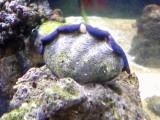
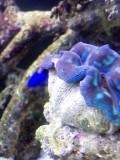 |
|
Derasa Clam, hlth., comp. 9/24/08 Hello, this
is my first question but I read your recommendations since a long
time ago. Sorry my English is not perfect. <I understand
you> My reef setup is running since a year and a half ago.
Among many corals and invertebrates I have these two clams since
a year ago. A derasa and I think a Crocea, but im not sure about
that. The two clams where very good till now. The crocea is still
very good but I see the derasa not extending the mantle as before
like 10 days ago. I try to move the clam when I notice that the
two shells were like disassembled and feels like the top shell
was going to fell. <Yikes, no bueno> I leave the clam and
not touched anymore. I was very careful and Im sure that I
didn't do the damage. She opens a little and the color is
good and sometimes close and open a little but Im not sure if she
can recover by herself. Is not getting worse at least. I include
a photo where you can see the two clams and you can see that the
top shell is like a couple millimeters off the natural position.
The water parameters are Ammonia 0 Nitrites 0 Nitrate 10
Phosphate 0 Carbonate hardness 8 Calcium 400 Temperature 80 I
don't have a chiller and its a 30 gallon tank 196 watts PC
and the calms are very high and in the center of the tank
Thanks!!!! Fernando <I think this animal is being poisoned by
either the Zoanthid below or the Polyp above. I would move either
the clam or these stinging-celled colonies. Bob Fenner>
|
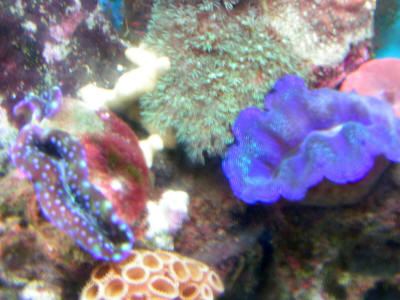 |
|
|

